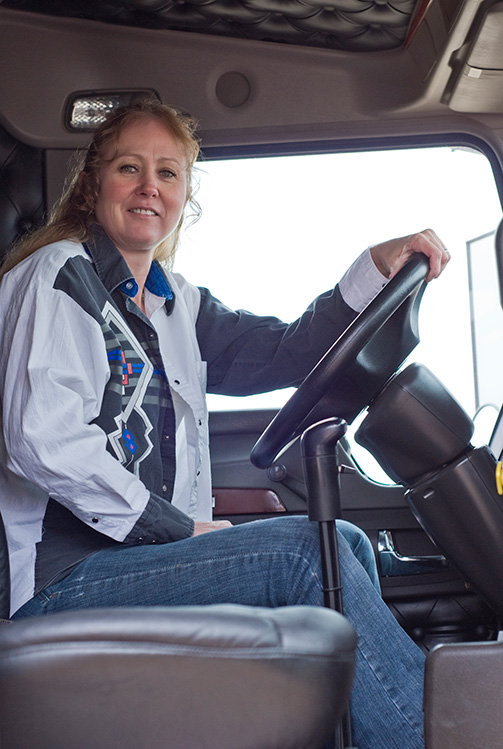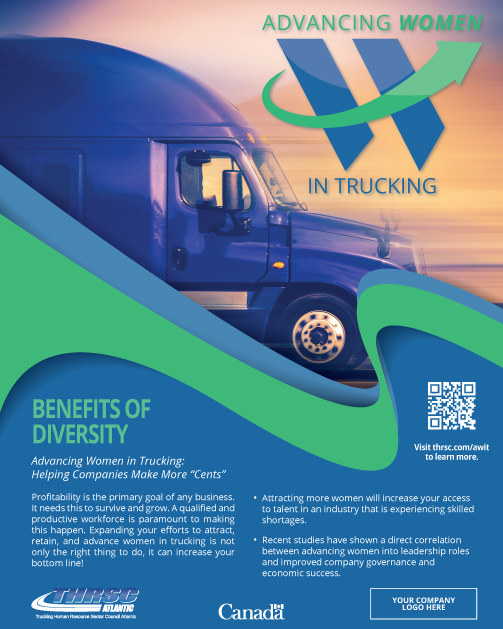Making the Case
Benefits of Diversity
Advancing Women in Trucking: Helping Companies Make More “Cents”
Profitability is the primary goal of any business. It needs this to survive and grow. A qualified and productive workforce is paramount to making this happen. Expanding your efforts to attract, retain, and advance women in trucking is not only the right thing to do, it can increase your bottom line!
- Attracting more women will increase your access to talent in an industry that is experiencing skilled shortages.
- Taking a serious look at your company culture and benefits to ensure gender diversity can decrease costly turnover for all employees.
- Recent studies have shown a direct correlation between advancing women into leadership roles and improved company governance and economic success.
Let’s do the MATH!

- Women currently occupy 48% of the workforce in Canada 48%
- Comparatively, only 3% of Professional truck drivers are female 3%
- Less than 2% of Truck Mechanics are female 2%
- and 16% of Managers in Transportation are female 16%
In order to attract, retain, and advance women in trucking, advocates of gender diversity are promoting things such as:
- better training and adherence to set standards,
- flexible work schedules and better benefits,
- improved working conditions, and
- inclusive culture with improved communication
Are you offering this to your workforce? Consider applying for the THRSC Atlantic’s Employer of Choice Program. This program will not only give you valuable insight into what your current workforce values, it will also help you build your HR business plan to include best practices for gender diversity at your workplace.
Fortune 500 companies with the most women on the board of directors outperformed companies with the least.
- Return on Equity: On average, companies with the highest percentages of women board directors outperformed those with the least by 53 percent.
- Return on Sales: On average, companies with the highest percentages of women board directors outperformed those with the least by 42 percent.
- Return on Invested Capital: On average, companies with the highest percentages of women board directors outperformed those with the least by 66 percent.
Retrieved from: www.catalyst.org, www.apeg.bc.ca
Benefits of Diversity Poster Download:
Are women competent to do the non-traditional jobs in trucking?
According to one business owner…
Dispelling the Myths About Women in Trucking

Although we have seen revolutionary changes in the trucking industry in the last two decades, one thing has been slow to change; the public’s perception of who we are and how we do business.
According to Statistics Canada, Truck Transportation is a growing industry, which has positive job opportunities for the future.
This positive outlook can benefit both genders as males are no more suited for careers in trucking than females despite what has occurred traditionally.
So let’s put away our past biases and consider the facts:
Myth or Reality: Fact Sheet

Trucking has one of the lowest female participation rates in Canada
 Truck transportation (484) is the largest subsection of the North American Industry Classification System (NAICS) for the Transportation and Warehousing industry in Canada yet it has one of the lowest female participation rates at only 14%.
Truck transportation (484) is the largest subsection of the North American Industry Classification System (NAICS) for the Transportation and Warehousing industry in Canada yet it has one of the lowest female participation rates at only 14%.
Comparatively women in other subsections such as Postal Services (491) and Air Transportation (481) have the highest female participation rates with 50% and 39% respectively.
One of the biggest reasons for the low female participation rates in truck transportation is that there is only 3% of women who are employed in the occupation of Transport Truck Driver (NOC 7511) yet this occupation alone account for 65% of all jobs in this subsector.
Retrieved from: http://apgst.ca/projects/pdfs/APG_WIT_web.pdf
Except for clerical positions, men are better suited for jobs in trucking
 Competencies (the skill, ability and knowledge) to do a job are not gender specific. Being male or female DOES NOT determine whether you will be good at one job or another.
Competencies (the skill, ability and knowledge) to do a job are not gender specific. Being male or female DOES NOT determine whether you will be good at one job or another.
The fact that there is more of one gender in a particular job or industry does not prove they are more suited for that occupation. It does show, however, that our culture or society has or have had certain gender expectations when it comes to choosing employment.
On the contrary, despite the fact that in Canada there are only 3% of Professional Truck Drivers are female, some carrier’s are asserting that they are statistically safer. They are on average involved in fewer accidents and are receiving less highway violations than their male counterparts, according to some trucking companies who employ female drivers.
According to Derek Leathers, COO of Werner Enterprises who employ 9000 truck drivers, female drivers are outperforming males with fewer accidents and compliance and safety issues.
http://www.blog.sidgilreath.com/trucking-accidents/women-truckers-increase.html
The trucking industry offers rewarding and professional careers for women.
 Within the trucking industry there are a wide range of rewarding and professional careers for women. These careers range from administrative and support services to operational occupations, all with potential paths into management roles. Those who think there is nothing for women in trucking should look again.
Within the trucking industry there are a wide range of rewarding and professional careers for women. These careers range from administrative and support services to operational occupations, all with potential paths into management roles. Those who think there is nothing for women in trucking should look again.Women can make more money in non-traditional jobs/role than they can in traditional jobs.
 Although there are many reasons gender pay inequity exists within Canada, the fact is that many traditional jobs occupied by women are rated or valued lower than non-traditional jobs. This is true for the trucking industry as well.
Although there are many reasons gender pay inequity exists within Canada, the fact is that many traditional jobs occupied by women are rated or valued lower than non-traditional jobs. This is true for the trucking industry as well.
A Professional Truck Driver (NOC 7411), for example, has a higher earning potential than the Data Entry Clerk (NOC 1422) yet there are only 3% female truck drivers. Comparatively, Data Entry Clerks in the trucking industry have a female representation rate of 86%.
Other non-traditional occupations in the trucking industry that would give females higher earning potential are:
- Mechanics, transport trailer technicians
- Managerial staff
- Safety and loss prevention specialists
- Dispatchers
- Parts technicians
According to recent data collected, Women in Canada earn on average $0.82 to every $1.00 earned by their male counterpart.
http://www.catalyst.org/knowledge/womens-earnings-and-income#footnote6_mzlnuqm
More specifically, under the Occupational Major Group of Trades, Transportation and Equipment Operators, and Related Occupations women are earning only 74.1% as a percentage of male income.
http://workforceplanningboard.com/Files/English/Non-Traditional_Careers_for_Women.pdf
Men make better leaders in the trucking industry
 Although there are currently more men in leadership roles in the trucking industry in Atlantic Canada, this is slowly changing.
Although there are currently more men in leadership roles in the trucking industry in Atlantic Canada, this is slowly changing.
Advancing Women in Trucking by George Fullerton
In fact there are several business articles published today that argue females make better leaders or managers than their male counterparts. Although certainly a fresh perspective, it is still an observation and not biologically a pre-determined fact based on gender.
Fortune 500 companies with the highest representation of women board directors attained significantly higher financial performance, on average, than those with the lowest representation of women board directors, according to Catalyst’s most recent report, The Bottom Line: Corporate Performance and Women’s Representation on Boards.
Summary: Companies with higher representation of women in senior leadership roles are, on average, financially outperforming companies with the lowest.
http://www.catalyst.org/media/companies-more-women-board-directors-experience-higher-financial-performance-according-latest
Roy D. Adler and his colleagues at the Pepperdine University found the “correlation between high-level female executives and business success has been consistent and revealing.”
http://garfinkleexecutivecoaching.com/articles/men-and-women-in-business-leadership
Women in Trucking are not advancing
 Today in Canada the rate of female participation in management positions in the transportation and warehouse industry is the same as all other industries at 24%.
Today in Canada the rate of female participation in management positions in the transportation and warehouse industry is the same as all other industries at 24%.Retrieved from: http://apgst.ca/projects/pdfs/APG_WIT_web.pdf
In Atlantic Canada, we are seeing more women advance to supervisory and managerial levels in the trucking industry than ever before. In a survey recently conducted by the THRSC Atlantic, 1/3rd of the respondents in Atlantic Canada held a supervisory or managerial role. The survey also revealed that over 40% of those women who responded are interested in some type of career advancement in the next 5 years.
The THRSC Atlantic has recently offered a Supervisory Development Program to the trucking industry. Employers are sponsoring female participation at a rate of 3 to 2 in this program indicating support of women advancement.
http://www.ontariotruckingnews.com/magazine/featured-articles/420-advancing-women-in-trucking
The strategies needed to recruit and retain women in trucking will benefit everyone.
 Many of the strategies/tools found on this website will not only attract and retain women, they will go a long way to attracting and retaining a competent workforce. Raising your company’s level of involvement in your community, offering benefits and flexibility to support employees and their families, as well as developing and implementing policies and training that support a diverse workforce, will make you more appealing to any applicant and enhance the workplace for all employees.
Many of the strategies/tools found on this website will not only attract and retain women, they will go a long way to attracting and retaining a competent workforce. Raising your company’s level of involvement in your community, offering benefits and flexibility to support employees and their families, as well as developing and implementing policies and training that support a diverse workforce, will make you more appealing to any applicant and enhance the workplace for all employees.Safety and security is a big concern for women in trucking
 Safety and security is a big concern for all people in trucking, especially those who find themselves working alone or travelling for work. Cargo crimes as well as personal assaults are all too real in today’s trucking industry for both genders. Good employers understand this and have developed and implemented policies and training programs such as the Prevention of Violence in the Workplace and Working Alone policies to keep their employees safe while on the job.
Safety and security is a big concern for all people in trucking, especially those who find themselves working alone or travelling for work. Cargo crimes as well as personal assaults are all too real in today’s trucking industry for both genders. Good employers understand this and have developed and implemented policies and training programs such as the Prevention of Violence in the Workplace and Working Alone policies to keep their employees safe while on the job.
Statistically in Canada, women are 3 times more likely to be victims of sexual assault in the workplace, regardless of the industry. As a result, it is important that employers recognize women are at a higher risk and they have a duty to ensure a safe a healthy work environment by promoting a respectful and harassment free workplace regardless of the industry.
Retrieved from: http://www.canadianbusiness.com/blogs-and-comment/sexual-harassment-in-canada-statistics/
Non-traditional jobs in trucking are physically demanding, dirty and not very feminine.
 Throughout history, women have been no strangers to physically demanding work, both in and out of the home. So-called traditional female jobs such as home care, nursing, and food service can expose female workers to unclean working environments and physical conditions that require increased physical strength or exertion.
Throughout history, women have been no strangers to physically demanding work, both in and out of the home. So-called traditional female jobs such as home care, nursing, and food service can expose female workers to unclean working environments and physical conditions that require increased physical strength or exertion.

Princess Elizabeth in the Auxilliary Territorial Service
Today, advancements in technology and the promotion of safe work practices allow all workers, regardless of gender, to work in healthy environments with a minimized risk of injury. Automatic transmissions, lifting devices, and properly ventilated work areas are just a few of the advancements that have made non-traditional trucking jobs such as the Professional Truck Driver and Truck Mechanic better for everyone.
INTERESTING FACT: In February 1945, Queen Elizabeth II joined the Women’s Auxiliary Territorial Service and trained as a driver and mechanic and was promoted to honorary junior commander five months later.
Retrieved from: https://en.wikipedia.org/wiki/Elizabeth_II
Image source: http://media.iwm.org.uk/iwm/mediaLib//20/media-20543/large.jpg.
This is photograph TR 2832 from the collections of the Imperial War Museums.
Women who work in non-traditional industries like trucking are looking for special treatment.
 Generally women in non-traditional jobs such as Professional Truck Driver and Truck Mechanic are uncomfortable with the attention that comes with being in a minority in the workplace. They find themselves often having to work harder to overcome gender biases and out-dated stereotypes.
Generally women in non-traditional jobs such as Professional Truck Driver and Truck Mechanic are uncomfortable with the attention that comes with being in a minority in the workplace. They find themselves often having to work harder to overcome gender biases and out-dated stereotypes.
The movement to encourage more women in trucking is not about hiring women regardless of their qualifications. It is about breaking down obstacles and barriers so that equally competent individuals, regardless of gender, can have the same opportunities.
Employment Equity: It’s the Law

By law, employers in Canada are responsible to ensure equity in the workplace. This includes gender equity. What this means and which legislation you are responsible to follow depends upon the jurisdiction under which your company operates.
Ensuring a person’s sex or gender does not interfere with his or her employability, pay and/or advancement is an employer’s responsibility. Employment equity is about hiring, retaining and advancing the best person for the job.
Employment equity DOES NOT mean that women must be afforded special treatment or employment opportunities despite her qualifications or ability. On the contrary, employment equity has been legislated to eliminate employment barriers that have existed and to improve a woman’s access to all occupations including those in trucking that are traditionally male-dominated.
To deny someone employment opportunities for any reason unrelated to ability can be considered discriminatory. Sometimes accommodations must be made to prevent or eliminate discriminatory practices
Something to think about:
Check out this True Story
A trucking company, owned and operated out of Atlantic Canada, has a practice of hiring several newly licensed drivers per year. Unlike experienced drivers, these new employees were expected to start their employment under a formalized coaching program for new drivers. This required them to travel with a trained coach for a period of time until a level of competency was achieved. As many of these new drivers were training to be long-haul drivers, this arrangement meant sleeping in the truck for a period of time. In 2014 a newly licensed female driver applied for employment as a long haul driver. Her knowledge, attitude and skills were exactly what the company looked for in a newly licensed employee.
How could the company deal with the overnight issue without putting the coach or the new employee in an uncomfortable position? At first the hiring manager began to look for a female coach. The company did have a couple of female drivers, however, both were local and neither had the willingness to coach new drivers. It soon became apparent that the “on-the-road over night” issue was a minor employment barrier that could easily be overcome. The manager worked with dispatch to develop a training plan that would keep the coach and trainee local for the majority of the training program and when overnight was required, “out of truck accommodations” such as hotel rooms were arranged that were suitable for both parties. From a legal perspective, the company had fulfilled its duty to accommodate. From a company perspective, the extra investment into an employee has paid off. The female driver continues to work for the company incident-free and remains loyal to her employer and grateful for the employment opportunity.
If you are a federally regulated employer
If you are provincially regulated in one of the 4 Atlantic Provinces
FEDERALLY REGULATED EMPLOYER
The Canada Human Rights Commission is a federal organization created to promote the principle of equal opportunity including gender equality. It is empowered under the Canada Human Rights Act to investigate and try and settle complaints of discrimination in employment for organizations and companies under federal jurisdiction.
For more information, please visit: http://www.chrc-ccdp.gc.ca/eng
Here you will learn more information regarding your obligations, your duty to accommodate and how to set up an internal process for resolving complaints.
Equal Opportunity for Employment in Canada is legislated by the Employment Equity Act. As a federally regulated company, you are expected to uphold the principles of this Act by eliminating employment barriers for women and three other designated groups and to increase their representation in workplaces where they have been traditional underrepresented.
- The Truck Transport sector in Canada has a 14% overall representation of females employed. 14%
- Comparatively, the workforce in Canada has an overall female representation of 48%. 48%
- Regardless of your company’s size, you are legally required to follow the Canada Human Rights Act
- If you have 100 or more employees you are required to adhere to the Legislated Employment Equity Program that requires you to file an annual report to the Labour Program, which includes information on your previous year’s overall workforce and the four designated groups. For further information see: http://www.esdc.gc.ca/en/jobs/workplace/human_rights/employment_equity/leep.page
- If your representation numbers are below that of your sector, you can be subject to a compliance audit conducted by the Human Rights Commission. See: http://www.chrc-ccdp.ca/eng/content/employment-equity#7
PROVINCIALLY REGULATED EMPLOYER
Know your Responsibility!
For more information on your legal obligation to ensure equity in the workplace, please visit the following applicable provinces in which you operate:
Trucking: The Current Situation
If your business is experiencing a skills shortage that is negatively impacting your bottom line, you are not alone. GE Capital surveyed leaders in mid-size trucking firms throughout Canada in 2014 (with revenues between 10 million and 1 billion dollars) and it was noted that next to the cost of doing business; the need for a qualified workforce is a top concern of business leaders in the trucking industry.
In Canada, women make up 48% of the workforce but are underrepresented in the trucking industry totally only 14% of the truck transport sector. A focused approach to the recruitment, retention and advancement of women in trucking will not only address the issue of female under-representation, it can help deal with the issue of a qualified labour shortage.
Canada’s transportation industry is forecasted to see a 31% increase in labour demand between 2010 and 2030. The Canadian truck transportation sector alone is projected to employ 369,000 people by 2021. To meet this demand the sector will require at least 153,000 additional workers, an average of 14,100 per year. At the current rate of vacancies and the retirement projections of an aging workforce, labour shortages are expected to amount to over 26,000 full year jobs by 2030.

People employed by 2021
Additional workers required
Labour shortage by 2030
Although a lack of a qualified workforce is threatening many occupations in trucking such as managerial roles and truck mechanic, the shortage of qualified truck drivers remain one of the most acute issues as it impacts over two thirds of the entire trucking industry workforce. Nationally, women only comprise of 3.2% of the total Professional Truck Driver population. If we use the statistic that there are 300,000 truck drivers in Canada in both for hire and private carriers than 3% or 9000 of these drivers are female.
We have females in the workplace that are extremely effective, great employees and really love this type of work. I think traditional ways of thinking need to be put aside. [Trucking] provides opportunities for anyone who has a passion in this industry.
Just Imagine:
A concerted effort by the trucking industry to increase the percentage of women truck drivers by a mere 1% per year would add 3,000 truck drivers every year to the system and aid in the reduction of projected vacancies. By 2030, women would still be under represented with less that 20% representation but would have added a third of the workforce projected to be needed. Check your company data to determine how many women truck drivers you have employed. Now imagine what would happen if you, along with the other 31,000 trucking companies registered in Canada, increased it’s percentage by at least one every year?
Consider This:
Perhaps it may be time to invest in your own people. Is there a female on your front desk or at the computer entering data that has dreams of the open road? It is not uncommon for us to take the professional truck driver and convert him/her to the office and advance them to managerial roles with some time and investment. Perhaps it might be worthwhile to consider giving a female in your office the opportunity to become a truck driver or truck mechanic and have the potential for higher paying jobs.
Sources:
- GE Capital (3Q 2014) Canadian Mid-Size Trucking Industry Outlook.
Retrieved from http://www.gecapital.ca/GECA_Document/Industry_Summary_Trucking.pdf- Women in Transportation Careers – Understanding Participation in Canada. Asia Pacific Gateway Skills Table. (June 2015)
Retrieved from http://apgst.ca/projects/pdfs/APG_WIT_web.pdf- Understanding the Truck Driver Supply and Demand Gap and its Implications for the Canadian Economy. (Feb 2013) Conference Board of Canada.
Retrieved from http://www.conferenceboard.ca/e-library/abstract.aspx?did=5345- Beyond the Wheel. Final Report for Industry.
Retrieved from Canadian Trucking Human Resource Council. (2012) http://www.truckinghr.com/sites/default/files/documents/Final%20Report%20for%20Industry%20-%202012.12-029.en.pdf











